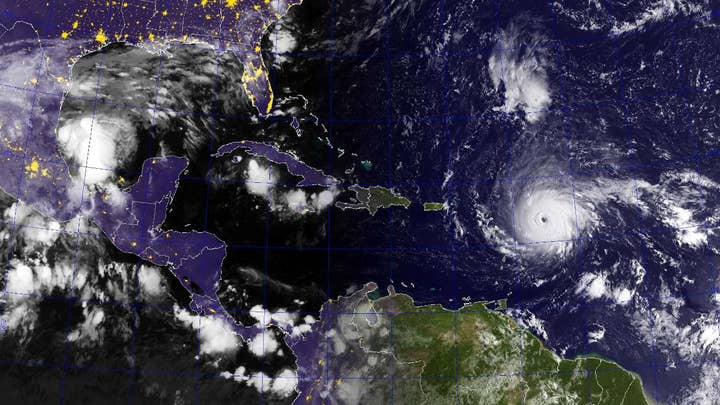As Hurricane Irma barreled toward the Caribbean on Tuesday -- on a path that could send the Category 5 megastorm toward Florida -- people up and down the state were starting to prepare for the worst.
President Trump declared emergencies in Florida, Puerto Rico and the U.S. Virgin Islands, which allows for the Department of Homeland Security and FEMA to coordinate disaster relief efforts there.
"If there is an evacuation order in your area, please follow it," Florida Gov. Rick Scott said Tuesday. "We can rebuild your home but we cannot rebuild your life."
The hurricane packed maximum sustained winds of 185 mph late Tuesday afternoon and was traveling west at 15 mph, the U.S. National Hurricane Center reported in its 8 p.m. ET advisory. The storm was roaring toward the Leeward Islands. Irma’s center was about 85 miles east of Antigua and approximately 90 miles east-southeast of Barbuda, the advisory said.
Forecasters warned the Florida Keys are especially at risk for possible damage. “People who are living (in the Florida Keys) or have property there are very scared, and they should be,” MIT meteorology professor Kerry Emanuel said.
Hurricane Allen hit 190 mph in 1980, a record for modern-day storms, while 2005's Wilma, 1988's Gilbert and a 1935 storm hitting the Florida Keys all had 185 mph winds.
Florida was in a state of emergency on Tuesday. At immediate risk were the small islands of the northern Leewards, along with the British and U.S. Virgin Islands and Puerto Rico.
"Some fluctuations in intensity are likely during the next day or two, but Irma is forecast to remain a powerful category 4 or 5 hurricane during the next couple of days," the National Hurricane Center warned.
FLORIDA GOV. RICK SCOTT DECLARES STATE OF EMERGENCY
Forecasters said there's a growing chance that Irma’s effects may be felt in Florida later this week and during the weekend.
Officials in the Florida Keys geared up to get tourists and residents out of Irma’s path, and the mayor of Miami-Dade county said people should be prepared to evacuate Miami Beach and most of the county's coastal areas. People across the state also stocked up on drinking water and other supplies.
“We’re just evacuating, getting out-of-town before everybody else does,” Luann Huff of Key West told CBS Miami, which reported that she was traveling to the central part of the state.
Miami's Deputy Director of the Building Department Maurice Pons advised against anyone staying near any of the city's 20 to 25 construction cranes. The cranes can "withstand winds up to 145 miles per hour, not a Category 4 Hurricane."
“For the Florida Keys, if you were to create the worst case scenario that is what we are looking at,” Monroe County Emergency Operations Center Director Martin Senterfitt was quoted as saying by the station.
Scott activated 100 members of the Florida National Guard to be deployed across the state, and 7,000 National Guard members were to report to duty Friday when the storm could be approaching the area.
On Monday, Scott declared a state of emergency in all of Florida's 67 counties. He said, “In Florida, we always prepare for the worst and hope for the best and while the exact path of Irma is not absolutely known at this time, we cannot afford to not be prepared.”
Scott ordered the suspension of road tolls across the state on Tuesday, saying in a statement, "They will be suspended for the duration of the storm’s impacts to Florida."
He told media at a Tuesday briefing that there will be a mandatory evacuation for Monroe County on Wednesday morning, and that Miami-Dade county has been advising people in "low-lying areas" to begin evacuation on Wednesday.
If Irma hits the Florida Straits, the water there is warm enough that the already “intense” storm could become much worse with wind speeds potentially reaching 225 mph, Emanuel warned.
The storm’s eye was expected to pass about 50 miles from Puerto Rico late Wednesday.
"Puerto Rico has not seen a hurricane of this magnitude in almost 100 years," Carlos Anselmi, a National Weather Service meteorologist in San Juan, told The Associated Press.
Both Puerto Rico and the U.S. Virgin Islands expected 4 inches to 10 inches of rain, according to the National Hurricane Center advisory.
TROPICAL STORM JOSE FORMS IN THE ATLANTIC OCEAN
Miami-Dade County Mayor Carlos Gimenez said the voluntary evacuations could begin as soon as Wednesday evening. He activated the emergency operation center and urged residents to have three days' worth of food and water.
A new tropical storm also formed in the Atlantic on Tuesday, to the east of Irma.
The hurricane center said that Tropical Storm Jose was about 1,505 miles east of the Lesser Antilles with maximum sustained winds of 40 mph. It was moving west-northwest at 13 mph and was expected to become a hurricane by Friday.
Fox News' Travis Fedschun and The Associated Press contributed to this report.


